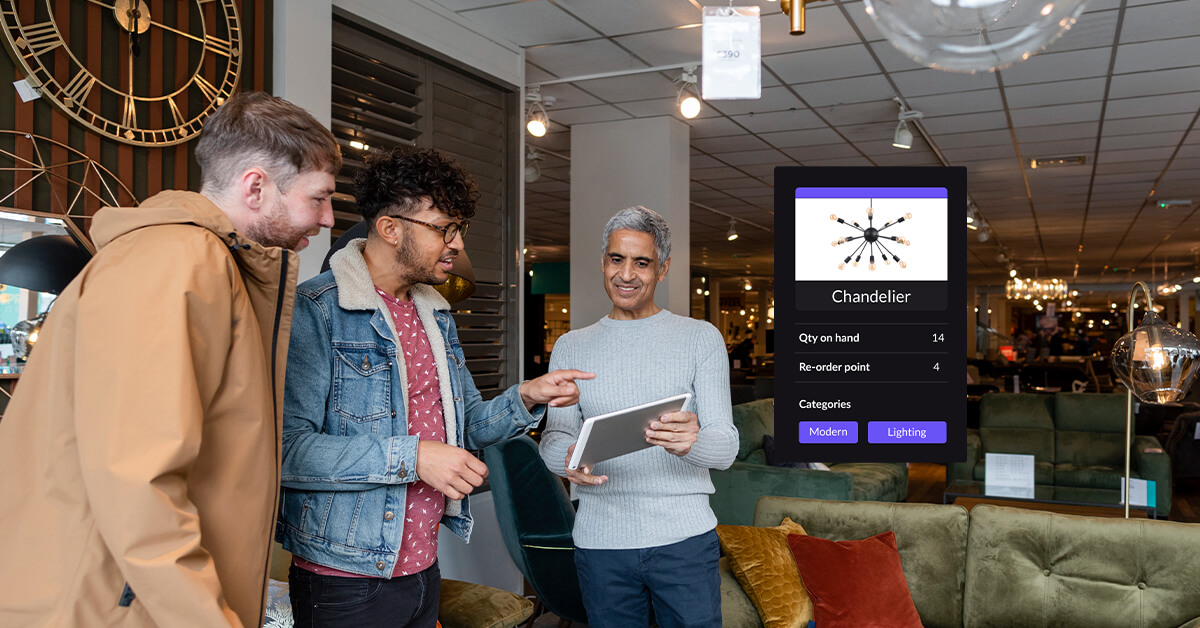
Technology has changed the way we shop forever. When we can buy whatever we want, wherever we are, with the click of a button.
The idea of the retail store’s purpose has also changed. While it once existed strictly as a place to transact changes, retail stores have started leveraging experiences to customers rather than products.
As retail looks to reposition how brick-and-mortar stores fit into the customer journey, experience has become a key marker. Shops are looking to give customers things that can’t be easily replicated online, and creating tactile, engaging experiences has become top of the list.
What is experiential retail?
The term “experiential retail” gets thrown around a lot, but what does it actually mean? We’ve defined five things that differentiate experiential retail from traditional retail:
What does experiential retail do differently than traditional retail?
- Creates an immersive and shareable experience
- Prioritizes customer engagement—not sales
- Helps nurture communities
- Inspires new approaches
- Stimulates your customers’ senses
- Take an omnichannel approach
- Defies customer expectations
- Leverages in-store events and services
- The store experience addresses consumer needs
Prepare your business for the future of commerce
Download our free playbook and learn how to sell on different channels, boost loyalty and increase foot traffic with technology.
Experiential retail is immersive and shareable
It’s no secret that consumers are craving for experiences that they can share on social media. As AdWeek puts it, “These days, if consumers can’t Instagram a store, it’s almost not even worth going.”
This is particularly evident in younger generations — i.e., Gen Y and Gen Z. These consumers are digital natives, many of whom have lives that are well-document on social media.
If you want to captivate these audiences, you need to give a social media reason to check out your shop. And what better way to do that than by setting up an Instagram wall in your store?
Plan organic photo opportunities for customers
User-generated content can be a very cost-effective way of marketing to and engaging with customers. Thoughtful store design that enables (but never begs for) authentic, organic photo opportunities is the key to mastering user-generated in-store content.
Pete Trentacoste, environmental design director at Casper, sheds light on their philosophy and approach to experiential retail:
“We try to make the stores and the space itself beautiful and inspire good looking pictures, but we’ll never put a hashtag on the wall,” he said. “We’re never going to be like: ‘Take this picture here.’ It just feels a little forced.”
Casper’s New York experiential store, The Dreamery, is anything but ordinary.
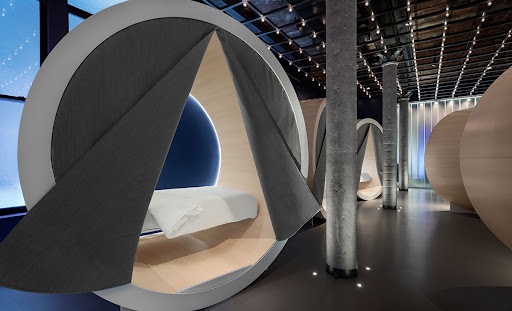
New York is known as the city that never sleeps, which for Casper and health practitioners everywhere, is a problem. Their store experience aims to help more people sleep better while positioning their products as the catalyst for getting better sleep.
Rather than sell their mattresses, customers can pay $25 for 45 minutes in a private sleeping pod. Each pod uses a Casper mattress, sheets, and pillows, along with a fully-equipped bathroom to freshen up after your nap.
Casper aligned their company’s mission (help bring great sleep to more people) and product in-store events (rest in unmatched comfort) with their store concept. As their CMO, Jeff Brooks, says, their aim was to create a space that was calming and restful, but also evoked the spirit of the brand.
Experiential retail’s priority isn’t sales; it’s engagement
An experiential retail store’s primary focus isn’t sales (counterintuitive, we know), it’s curating a completely on-brand experience from the moment a customer walks through its doors onwards.
Let’s take direct-to-consumer brand Glossier, for example.
The company’s customer-centric philosophy can be felt at every customer touchpoint. Their social media features tons of customer-generated content; the products they make are informed by their customer’s feedback; their NYC flagship store personifies Glossier’s personality: magical.
Ali Weiss, SVP of Marketing for Glossier, says “The retail stores are a calculated, true representation of the Glossier brand and what the experience should be. We definitely take risks, but we analyze how it will impact the consumer experience before we do anything.”
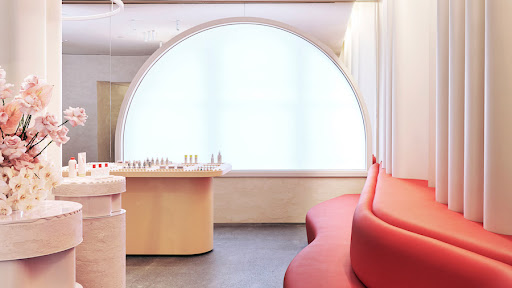
“In our NY flagship store, there is no stationary place for transactions. Our customers come to get lost in an experience, trial and conversation. The showroom editors offer peer-to-peer recommendations. When you’re ready to buy, editors check you out on an iPad wherever you may be in the store. The product is then delivered from the sky via a conveyor belt. It’s a magical experience.”
Their target market, Millennials, are connected online 24/7, yet they still flock to the store and wait in long lines just to get in.
They aren’t waiting in line to buy products; they can easily just do that online.
They’re waiting in line to experience a brand that actively engages them by including them in their branding and product development.
The key takeaway from Glossier’s approach to retail? If you focus on creating an experience that engages with customers (and you sell quality products with friendly, approachable service), the customers will respond incredibly well—with their loyalty and their buying power.
Experiential retail helps nurture communities
Physical spaces can bring people together in ways that websites or mobile apps can’t. As a brick-and-mortar store, that’s one of your most significant strengths. Use it to your advantage.
Figure out how you can use your shop to build communities. Can you hold classes or events? Are there spaces or elements in the location that would encourage people to meet and get together?
Take, for example, Solfire, an athleisure apparel retailer in Brooklyn. Solfire wanted to bring about a sense of community in its store, so the team set up a juice and smoothie bar and a “fitness oasis” — a space for clubs to meet and classes to exercise. Solfire also added community board to showcase “all the studios, all the places people sweat, all of that within the area around the store.”
Here’s another idea: consider creating a space where people can use your products. This was the intention behind the Levi’s Stadium in California. At NRF 2018, Levi’s president James ‘JC’ Curleigh said that they built the stadium because they wanted to promote amazing experiences and build a space where people can wear Levi’s jeans.
You may not have the capabilities to build a stadium, but use that same mentality in your customer experience strategy. Ask yourself, can you create a space where your customers can use and experience the things that you sell?
One retailer that’s doing this right is Books@One, a bookshop in Ireland.
 You’d think that with ebooks and Amazon, anyone would be crazy to venture into physical book sales. But, as Books@One proves, running a brick and mortar bookstore can be very rewarding.
You’d think that with ebooks and Amazon, anyone would be crazy to venture into physical book sales. But, as Books@One proves, running a brick and mortar bookstore can be very rewarding.
What’s the secret behind the company’s success? One word: community.
“Here, we don’t just sell you a book. We’re a place to visit and become immersed in, a place where you can participate in community events, find out what’s going on in the area and the world, or just relax and enjoy a coffee and a chat,” says owners Brid Conroy and Neil Paul.
“We’re creating an atmosphere where people engage with books in a communal way again,” they added.
Experiential retail has borne a new approach, and even a new term: “retailtainment”
As the name suggests, “retailtainment” is all about fusing retail and entertainment to enhance the shopping experience. In many cases, retailtainment involves spectacles or attractions to grab the attention of shoppers.
What kind of retailtainment should you offer? That depends on your store and customers. In some cases, bringing in celebrities or industry professionals could do the trick.
In 2016, for example, Walmart stores in Little Rock Arkansas brought in professional bullfighters to sign autographs in-store. The stunt not only attracted a ton of foot traffic, but it got Walmart plenty of coverage from the local press.
Retailtainment could also mean giving people something they don’t see every day. Consider what clothing store New York & Co. did. In 2015, the NY&C store in Cerritos, California used real people instead of mannequins in their window displays.
The attraction got passers-by to stop and actually check out the store, because, let’s face it, how often do you see real-life “mannequins”?
Explore the idea, test it, and then see what happens. Our guide will walk you through the future-proof retail tactics that’ll keep your business flexible and efficient—a key to thriving in the new world of retail.
7 Ways to Run your Retail Store Smarter in 2023
Experiential retail stimulates your customers’ senses
One thing that physical stores do better than any other channel is to engage all five senses. This means they’re a great way to forge emotional connections with customers through personalized, engaging experiences.
Why is that important? Well, the Boston Consulting Group found that brands that focus on engagement and personalization see their revenue increase by 6% to 10%—almost three times faster than brands that don’t.
Lush has been doing experiential retail long before it became a buzzword. Its approach is also low-cost with a low barrier to entry. Want to know what that bath bomb looks like? Staff will take one right out of the display and demo it in one of the in-store sinks.
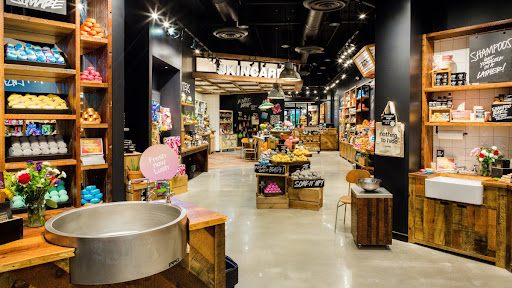
This simple approach means Lush stores are always hives of activity full of color, smell, and sound. But it’s also one of the reasons Lush can charge much more for soap and shampoo than your average pharmacy.
It seems commonplace today, but Apple’s tactile approach was ground-breaking at the time. Rather than products having to sit in boxes, customers were invited to explore and touch and fall in love with them. Touching a product can create a symbolic connection between people and products, which intensifies their desire to possess the product. It drives a feeling of ownership, which intensifies the need to make a purchasing decision.
Shopping in a store is no longer driven by necessity, it’s driven by a sense of discovery and the excitement of finding and experiencing something new.
In-store experiences that activate a customer’s senses lead them to have stronger emotional connections to the brand and its products or services.
Experiential retail is all about omnichannel
The key components of omnichannel retail experiences — including buy online pickup in-store, curbside pickup, and in-store fulfillment — are essential in today’s modern shopping environment. Getting these things right will keep shoppers coming back to your store and website.
Research from Google found that 98% of consumers switch devices throughout the day, so it’s important to be able to keep up.
Facilitate your customers shopping journeys as the move from channel or device to the next, by making it easy for them to purchase from you wherever they are.
And when it comes to order fulfillment, give people the option to get their hands on their products in the most convenient way possible. For some shoppers, this means shipping orders to their house. For others, it means giving them the ability to pick up their items in-store or curbside. Whatever the case, make sure you’re able to be there for your customers no matter where or how they’re shopping.
One of the best examples of a retailer that does this is Target. The company has invested in omnichannel, BOPIS, and curbside even before the pandemic, and this effort has paid off tremendously.
“I think everyone should be looking at Target for a best-in-class BOPIS example. Not everyone has the scale to implement BOPIS, curbside, and delivery in the same way that Target can, but there are several things that Target does that anyone can and should be emulating,” says Caila Schwartz, Senior Manager for Strategy and Insights RCG at Salesforce.
“The first, and in my opinion, the most important part of their BOPIS offering is that they put the focus on their customer. They know who their customers are and what they value.”
She continues, “This means that they’re putting efficiency first when it comes to picking up an order. Using tools like geofencing through their mobile app, they can anticipate when a customer is nearby and have that order ready to go. They also give their store associates the ability to compensate customers who may be waiting too long at curbside. The process is built to be seamless and customer-first.”
Experiential retail defies customer expectations
Over the years, consumers have been hardwired to expect certain things when they shop in a retail store, like products and a cash register.
But the rise of experiential retail has taken those expectations and completely defied them. Brands are opening spaces that are more flexible, like L’Occitane’s 555 store in New York, to make it easier to keep things looking fresh.
Meanwhile, other retailers are creating spaces that don’t look or function like stores at all.
Take South Korean eyewear brand Gentle Monster. Its stores are designed to look more like art galleries than an optician.
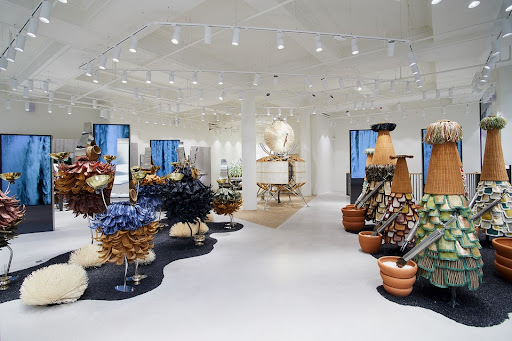
It uses them to bring its brand to life by filling each store with unique sculptures and installations. People may visit the stores purely to take photos or to explore, which in turn introduces them to the brand. Even the smell and soundtrack are different in each location, which makes visiting each store an experience in itself.
Create a curated experience
Shoppable apartments aren’t a new trend, but they’re a great example of how a store can become more of an experience.
The Line embodies this concept to a tee. Rather than selling fashion, home, and beauty products on shelves, or cramming furniture into a showroom, their carefully-curated spaces are designed to look like real living spaces.

Seeing all their products in context makes it easier for customers to imagine how they could incorporate those products into their lives. Shoppable apartments are also great for inspiration because they often look like dream homes. Customers then want to buy the products to recreate that curated look and feel in their own home.
By breaking away from the conventions of what a ‘store’ is, brands can offer customers a genuinely engaging experience that inspires them to buy.
Empower customers to personalise their purchases through product building
Enabling your customers to “build” their products can be a fascinating experience. People love the concept of personalizing an item and making it their own, so if it makes sense for your business, consider letting them do just that.
Dresden takes plastic waste from Australian beaches and discarded fishing nets and upcycles them into affordable frames. Dresden lets shoppers create their own pairs of sunglasses by enabling them to interchange the lenses and frame parts (which come in a variety of colors and sizes).
The result? Shoppers can purchase eyewear that’s unique, stylish, and environment-friendly.
Experiential retail leverages in-store events and services
Real-life spaces are great for connection, conversation and idea sharing, which is why in-store events have become a big part of the experiential retail trend. Your retail space is the ideal stage for showcasing what your brand is all about.
In fact, the best events are tied to the brand’s identity, such as a bookshop holding author talks or a sports brand having top players show up to sign autographs. They feel like an authentic extension and help to create an ecosystem around a company, rather than an obvious and manufactured attempt to create a connection.
Some stores, like Nike’s SoHo flagship store, have built-in event spaces. Its in-store basketball court, soccer trial space, and treadmills let customers try products out in their intended environment while having fun and socializing with people that share similar interests. Customers can also get more personalized advice based on how they move around these areas.
In-store events give customers a reason to visit outside of their normal purchasing habits. They help to create stronger bonds that keep your brand top-of-mind.
Experiential retail addresses consumer needs
Another great way to bring a brand to life is through service. While a lot of experiential retail seems focused on big production pieces, let’s not forget that there’s another side to experience.
Aside from its 4-star stores, Amazon doesn’t have physical stores, but over 100 million shoppers in the United States use it. Why? Because shopping with Amazon is, above all else, quick and convenient. Stores that are convenient and take less of a customer’s time will consistently draw customers back long after the Instagrammable displays and photo ops have grown old.
A Forrester report found that 66% of consumers think that a company valuing their time is the most important thing a company can do. This might mean exploring ways to remove the need to the lineup to pay by using modern technology to check customers out on the shop floor.
It might mean ordering a product that’s no longer in-store and shipping it directly to a customer’s home address.
Offer customer-centric services
Some brands are exploring offering additional services that serve customers’ needs outside of actually making a new purchase. This is important because most of us don’t buy something new every day, especially if the product’s life cycle is long. In certain product categories, like electronics, there may be quite a long time between purchases.
According to Statistica, the average life cycle for a smartphone in the United States is 2.9 years. So how do companies like Apple adapt? By offering in-store repairs and service at their Genius Bar.
Furniture stores such as Wayfair and IKEA have started incorporating home installation services into their offerings. IKEA did this by purchasing TaskRabbit, a platform that connects consumers with service providers who can do things like assemble furniture and install appliances.
Wayfair, on the other hand, partnered with Handy, an on-demand home service platform that connects consumers with household professionals.
Services like this mean the relationship doesn’t end with the initial sale. These could include personal shopping, tailoring, cleaning, repairs, training and more. Nordstrom has taken this approach with its micro Nordstrom Local spaces, using them as click-and-collect and service hubs, rather than fully-fledged stores.
Adding in complementary services like a nail salon and a tailoring service makes the experience especially attractive for customers.
Experiences sell
When done right, experiential retail is a great way to engage with customers beyond simply selling them products. It offers brands an opportunity to find ancillary ways to support their community of customers and establish themselves as more than just a product.
If your in-store experience resonates with customers and fulfills their needs beyond your product’s unique selling proposition (USP), that’s a powerful relationship builder. And customers will spend more money on the brands that succeed in doing so.
Experiences give consumers more reasons to visit your store. If all you can offer them is four walls to pay for something in, then why do they need to leave their house when they could do the same thing online?
Whether it’s entertainment, social interaction, discovery, convenience or something else, if you can identify what your brand can offer customers that they can’t get elsewhere, you can build an experience around it and separate brick-and-mortar operation from the pack.

News you care about. Tips you can use.
Everything your business needs to grow, delivered straight to your inbox.



